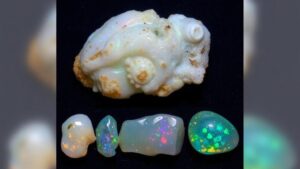Meteorite Hunting in Crater Lakes: Secrets Beneath the Surface
Meteorite Hunting in Crater Lakes: Secrets Beneath the Surface
For rockhounds and mineral collectors, meteorite hunting in crater lakes presents a unique and thrilling opportunity to discover extraterrestrial treasures. These natural formations, remnants of past cosmic collisions, often hold secrets beneath their tranquil surfaces, making them prime locations for enthusiasts and researchers alike.
The Science of Crater Lakes
Crater lakes form in the depressions left by meteorite impacts. The impact event can create a variety of geological features, including shatter cones, breccias, and sometimes even microscopic glass particles such as tektites. e impacts can range in scale; for instance, the well-studied Barringer Crater in Arizona is about 1,200 meters across and is believed to be around 50,000 years old.
Key statistics highlight the significance of these craters:
- Impact velocities for meteorites can exceed 20 km/s (about 45,000 mph).
- The Barringer Crater was formed by a nickel-iron meteorite weighing approximately 300,000 tons.
Why Crater Lakes are Ideal for Meteorite Hunting
Crater lakes not only serve as archaeological sites of cosmic history but also as locations where materials are preserved due to their unique environments. The water in these lakes helps to mitigate weathering and erosion, often keeping meteorites intact.
Also, the geological layers surrounding and beneath the lakes can reveal striking evidence of the historical impact events, including:
- Different sedimentary layers which may contain weathered pieces of meteorites
- Magnetic anomalies indicating the presence of ferromagnetic meteorite fragments
Practical Tips for Collecting Meteorites
The allure of crater lakes draws many collectors and scientists, each eager to unearth these pieces of the universe. But, successful meteorite hunting requires preparation and knowledge. Here are some practical tips to enhance your experience:
- Research Locations: Before embarking on a trip, conduct thorough research about known crater lakes like Lake Cretaceous or Tunguska Event sites.
- Use Magnetism: Employ magnetic metal detectors to locate iron-rich meteorites, as many meteorites have a higher iron content than terrestrial rocks.
- Observe Outcrops: Examine outcrops and sediment layers around the lakes edge. Fresh breaks in rocks can expose meteorite fragments.
- Check Local Laws: Always check the regulations related to collecting meteorites in your chosen location to ensure compliance with wildlife and conservation laws.
Potential Challenges
While crater lakes offer excellent hunting opportunities, they also pose challenges that collectors must navigate:
- Accessibility: Many crater lakes are located in remote areas that may require special permits or hiking to reach.
- Environmental Protection: Collectors should be aware of any protected status the area may have, as collection is often regulated in these sensitive ecosystems.
- Water Conditions: Always assess the safety of water conditions before exploring a crater lake, as high levels of silt or debris can make for dangerous conditions.
Real-World Applications of Meteorite Analysis
The importance of meteorite collections extends beyond personal achievement or academic curiosity. The study of meteorites can provide invaluable data about the early solar system, including:
- Understanding the composition of asteroids and how they relate to planetary formation
- Insights into the thermal and alteration histories of celestial bodies
- Evaluating potential resources for future space mining expeditions
Actionable Takeaways
Embarking on a meteorite hunting expedition in crater lakes is an exciting and intellectually rewarding endeavor. Here are a few takeaways to set you on the right path:
- Invest time in preparing and learning about the specific crater lakes geology.
- Use the latest technologies, such as drones or specialized detectors, to enhance your search.
- Join forums or local rockhounding groups to share experiences and tips with fellow collectors.
To wrap up, the potential for discovery in crater lakes lies not just in the thrill of the hunt but also in the deep connection to our universes history. With the right knowledge, tools, and respect for nature, rockhounds can uncover pieces of the cosmos–one meteorite at a time.



